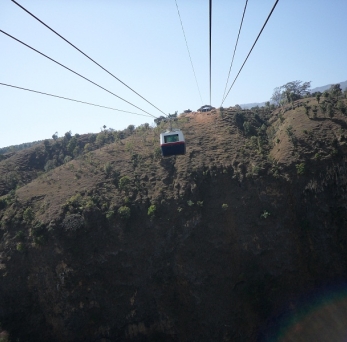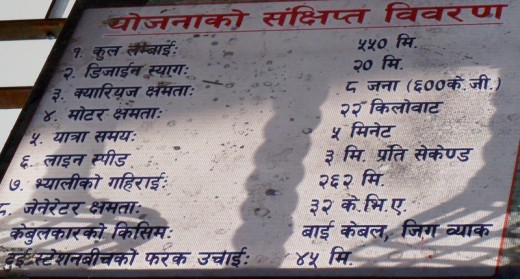बाग्लुङ अनी बलेवा ...
Wednesday, 20 March 2013
Saturday, 9 March 2013
बलेवाबाट कुश्मा पुग्न ५ देखि ७ मिनेटमा
बाग्लुङको बलेवा क्षेत्र र छिमेकी जिल्ला पर्वतको सदरमुकाम कुश्मा हेर्दा त नजिकै देखिन्छ। तर एउटा ठाउँ वारी र छ अर्को पारी। बीचमा कालिगण्डकी नदी। कुश्मा जान पैदल हिँडेर डेढ दुई घण्टा लाग्थ्यो। के गर्ने त ? पुलै बनाउने हो भने दूरी लामो भएकोले अति नै महँगो पर्छ। सरकारको मुखमात्र कति ताक्ने ? आफै किन केही नगर्ने ? यही सोचका साथ निजी क्षेत्र जुट्यो र केवल कार मोडलको यान्त्रिक पुल बनाउने सोचमा अगाडि बढ्यो। खर्च लाग्ने भयो झण्डै ५ करोड। अहो, यति धेरै रकम कसरी जम्मा गर्ने ? एकले थुकी सुकी, सयले थुकी नदी- यही उखान अनुसार उद्योग वाणिज्य संघले स्थानीय स्तरमै शेयर संकलन गर्न थाल्यो। जसले जति सक्छ, त्यति। २५ हजार रुपियाँदेखि १५ लाखसम्म गरी ४ सय ३५ जनाबाट रकम उठ्यो र गएको जेठ-असारदेखि पुल बनाउन थाल्यो नेपालकै रोपवे नेपाल प्रालिले। हिजो सोमबारदेखि यो व्यवसायिक रुपमा सञ्चालन हुन थालेको छ। अब बलेवाबाट कुश्मा पुग्न ५ देखि ७ मिनेटमात्रै लाग्छ।

यान्त्रिक पुल प्रयोग गर्न एकतर्फी भाडा अहिलेलाई सय रुपियाँ तिर्नुपर्नेछ। सार्कका पर्यटकलाई ३ सय रुपियाँ र विदेशीलाई सात डलर भाडा तोकिएको छ। प्रत्येक यात्रुको पाँच लाखको बीमा पनि गरिएको छ।
अहिलेलाई यो पुल निर्माण कम्पनीले हस्तान्तरण गरिसकेको छैन। त्यसैले परीक्षणको रुपमा व्यवसायिक सञ्चालन गरिएको हो हिजोदेखि। परीक्षणका क्रममा यात्रुको चाप, सञ्चालन खर्च, प्राविधिक समस्या हेरेर नयाँ भाडादर तोक्ने भनिएको छ।
दुई वटा यान्त्रिक कार (डब्बा) यो पुलमा जडान गरिएको छ। एउटा कारमा ८ जना अट्छन्। यो हिसाबले दुवैतर्फ गरी एकपटकमा बढीमा १६ जना आवतजावत गर्न सक्छन्। एउटा डब्बाको क्षमताका करिब पाँच क्विन्टल रहेको छ।
यो पुलको लम्वाई ४ सय ८७ मिटर छ। सो पुलमा दुवैतर्फ पोल गाडेर ५ सय ५० मिटर लामा छ वटा फलामका लट्ठा जडान गरिएको छ।
पुल निजी क्षेत्रको लगानीमा कुश्मा-बलेवा यान्त्रिक पुल लिमिटेडको स्वामित्वमा निर्माण गरिएको हो। यसले सरकारको मुख नताकी निजी क्षेत्र सक्रिय भएर आफै गरे पनि ठूल्ठूला काम संभव हुने देखाएको छ। व्यवसायिक रुपमा सञ्चालन भएर नाफा कमाउन थालेपछि यसको सफलताले सबैलाई दङ पार्ने पक्का छ।
कस्तो छ त पुल ? हेरौँ भिडियोमा-

कसरी काम गर्छ ?
मेकानाइज्ड वृज दोहोरो लठ्ठा दोहोरो दिशामा आधारित (Bi-Cable Bi-Directional) रोप वे हो। स्थानीय स्तरमा उत्पादित विद्युत्शक्ति नै यसको प्रमुख इन्धन हो। साथै डिजेलबाट चल्ने जेनेरेटर वैकल्पिक इन्धनको रुपमा व्यवस्था गरिएको हुन्छ। विद्युत्शक्ति र डिजेल दुबै उपलब्ध नभएको अवस्थामा तेस्रो विकल्पको रुपमा मानवशक्तिकै आधारमा सञ्चालन गरेर खोला पारी तर्न सकिन्छ। नियन्त्रण इकाइ (Control Panel) बाट स्विच दवाए पछि २५ अश्व शक्तिको (Horse Power, HP) मोर्टारले फित्ता (Belt) को सहायताले गियर बक्स घुमाउन थाल्छ र गियर वक्समा फलामको चक्का (Sheave) लाई तेर्सो पारि गाँसिएको हुन्छ। यसले गर्दा लठ्ठा घुम्दा बाँया किनाराको ट्रली दायाँ किनारा आइपुग्छ र दायाँ किनाराको ट्रली स्वतः बायाँ किनारा आइपुग्छ। अपरेटरले आवश्यकता अनुसार गति बढाउन तथा घटाउनका लागि क्लच सिस्टम (Clutch system) र ब्रेक सिस्टम (Break System) को पनि व्यवस्था गरिएको हुन्छ। यात्री बस्ने कोक्रो (Trolley) रोक्नको लागी प्लेटफर्म र ड्राइभ सचेतक (Sensor) को ब्यवस्था गरिएको हुन्छ भने सामान्य अवस्थामा अप्रेटरले सिवधको सहायताले रोक्न सक्छ। ड्राइभ टर्मिनल (Drive terminal) बाट अपरेटरले विद्युतीय मोटर चलाइदिएपछि लठ्ठा (तार) घुम्न थाल्छ जसमा ५०० के.जी. तौल सम्म पुर्ण सुरक्षित तरिकाले धान्ने गरि दुई वटा ट्रली जोडिएको हुन्छ। ट्रलीको माथिल्लो भाग लचकदार जोर्नी (Universal Joint or Ball and Socket Joint) को सहायताले भि ट्रयाक लठ्ठामा ८ ओटा पुल्लीसँग जडान गरिएको हुन्छ।
अप्रेटर तथा सर्वसाधारण यात्रुहरुलाई बुझ्न सजिलो होस भनेर प्यानल वोर्डमा रातो, हरियो तथा पहेलो रङ्गका स्विचहरुको समेत ब्यवस्था गरिएको हुन्छ , विश्वब्यापी यातायात सुचकहरुका साथमा भोल्टमिटर, एमिटर, तको आपतकालिन स्विच तथा शुरु गर्ने स्विच समेतको ब्यवस्था गरिएको हुन्छ। मेकानाइज्ड बृज सञ्चालन गर्नको लागी अप्रेटरलाई सामान्य प्राविधिक तालिम दिए पछि सञ्चालन तथा सामान्य मर्मतको लागि समेत सक्षम हुन्छन।
भिडियो हेर्नुस्-

यान्त्रिक पुल प्रयोग गर्न एकतर्फी भाडा अहिलेलाई सय रुपियाँ तिर्नुपर्नेछ। सार्कका पर्यटकलाई ३ सय रुपियाँ र विदेशीलाई सात डलर भाडा तोकिएको छ। प्रत्येक यात्रुको पाँच लाखको बीमा पनि गरिएको छ।

कसरी काम गर्छ ?
मेकानाइज्ड वृज दोहोरो लठ्ठा दोहोरो दिशामा आधारित (Bi-Cable Bi-Directional) रोप वे हो। स्थानीय स्तरमा उत्पादित विद्युत्शक्ति नै यसको प्रमुख इन्धन हो। साथै डिजेलबाट चल्ने जेनेरेटर वैकल्पिक इन्धनको रुपमा व्यवस्था गरिएको हुन्छ। विद्युत्शक्ति र डिजेल दुबै उपलब्ध नभएको अवस्थामा तेस्रो विकल्पको रुपमा मानवशक्तिकै आधारमा सञ्चालन गरेर खोला पारी तर्न सकिन्छ। नियन्त्रण इकाइ (Control Panel) बाट स्विच दवाए पछि २५ अश्व शक्तिको (Horse Power, HP) मोर्टारले फित्ता (Belt) को सहायताले गियर बक्स घुमाउन थाल्छ र गियर वक्समा फलामको चक्का (Sheave) लाई तेर्सो पारि गाँसिएको हुन्छ। यसले गर्दा लठ्ठा घुम्दा बाँया किनाराको ट्रली दायाँ किनारा आइपुग्छ र दायाँ किनाराको ट्रली स्वतः बायाँ किनारा आइपुग्छ। अपरेटरले आवश्यकता अनुसार गति बढाउन तथा घटाउनका लागि क्लच सिस्टम (Clutch system) र ब्रेक सिस्टम (Break System) को पनि व्यवस्था गरिएको हुन्छ। यात्री बस्ने कोक्रो (Trolley) रोक्नको लागी प्लेटफर्म र ड्राइभ सचेतक (Sensor) को ब्यवस्था गरिएको हुन्छ भने सामान्य अवस्थामा अप्रेटरले सिवधको सहायताले रोक्न सक्छ। ड्राइभ टर्मिनल (Drive terminal) बाट अपरेटरले विद्युतीय मोटर चलाइदिएपछि लठ्ठा (तार) घुम्न थाल्छ जसमा ५०० के.जी. तौल सम्म पुर्ण सुरक्षित तरिकाले धान्ने गरि दुई वटा ट्रली जोडिएको हुन्छ। ट्रलीको माथिल्लो भाग लचकदार जोर्नी (Universal Joint or Ball and Socket Joint) को सहायताले भि ट्रयाक लठ्ठामा ८ ओटा पुल्लीसँग जडान गरिएको हुन्छ।
Saturday, 16 February 2013
जिल्लाको नाम बागलुङ रहनुमा अर्थात बागलुङ शब्दको व्युत्पत्तिको धेरै किम्बदन्तीहरू ।
संस्कृत भाषामा व्यांघ्रालुनातीति शब्दमा "व्याघ्रको" अर्थ "बाघ" "लुनातीति"को अर्थ "लुञ" अर्थात छेदनु/ काट्नु वा मास्नु हो। कुनै समयमा यस ठाउँमा बाघै बाघहरूको ताँती हुनुको कारण यहाँको जनजीवन अति नै भयावह थियो। यस्तो डरलाग्दो वा दयनीय अवस्थालाई देखेर त्यस बेलामा मगर जातिका बलिया व्यक्तिहरूको समूहहरूको सक्रियतामा ती बाघहरूलाई छेदनु/ काट्ने वा मास्ने जस्ता काम गरेका हुँदा बाघहरूलाई मास्ने उद्देश्यले गरेको कार्यको अर्थमा यस ठाउँको नाम "बाघ्रलुञ वा ब्याघ्रलुञ" रहन गई अपभ्रंश भई बागलुङ रहन गएको मानिन्छ।
त्यस्तै गरी बाघ प्रचलित खस भाषा हो। "लुङ"को अर्थ लस्कर वा ताँती पंक्तिवद्ध वा लामको अर्थलाई जनाउँछ। त्यस समयमा बाघहरूको लस्कर लाग्ने थलो भएकोले यस ठाउँको नाम "बाघलुङ" रहन गएको र पछि बागलुङ भएको हो भन्ने भनाई पनि रहेको छ।
तिब्वती भाषामा "वाग"को अर्थ कहीं केही उठेको खण्ड र "लुङ"को अर्थ कहीं केही मैदान वा समथरलाई बुझाउँछ। यसर्थ "बागलुङ"को भौगोलिक वनावटलाई हेर्ने हो भने कतै उठेको र कतै मैदान वा समथर जमीनको भाग भएकोले पनि यस ठाउँको नाम बागलुङ रहन गएको हो भन्ने प्रष्ट हुन्छ।
Sunday, 30 December 2012
Narayansthan
Narayansthan is a village development committee in Baglung District in the Dhawalagiri Zone of central Nepal.It is located above the bank of kaligandaki River. Now, it has became one of the major important place in baglung. They have planned to construct the domestic Airport. At the time of the 1991 Nepal census it had a population of around 9000 and had 1500 houses in the town.
Ganesh Secondary School, Baglung Balewa
Sri Ganesh Secondary school was established in 1980 as a primary school and gradually it upgraded itself as a secondary school.
The school has proved itself as an example in the district. The students at the primary level are taught in English medium, which is unusual in a government school.
The school has aimed to teach up to class ten in English Medium in the coming days. And furthermore the school is equipped with the extra facilities such as computer education, library and lab for the use of students.
The school building was destroyed during a thunderstorm in 1993 and needed support for its reconstruction. The school was re-constructed with the support of the local community.
About Baglung District
Baglung District : a part of Dhawalagiri Zone, is one of the seventy-five districts of Nepal, a landlockedcountry of South Asia. The district, with Baglung as its district headquarters, covers an area of 1,784 km² and has a population (2011) of 268,613.
Baglung is surrounded by Parvat, Myagdi, Rukum, Ropla, Pyuthan and Gulmi districts. It has 59 Village Development Committees and one Municipality. It has many rivers and streams and so, many suspension bridges. Baglung is also known as the district of suspension bridges because of the large number of bridges. It is a hilly district, most of the population settled in the sides of the rivers. Fertile planes situated in the either sides of the rivers are used for farming. Headquarter of Baglung Distrikt ist Baglung Municipality which is also situated on the bank of the holy river- Kali Gandaki. Like Nepal, Baglung is also diverse in religion, culture, ethnicity, altitude, temperature etc. Hinduism and Buddhism are the major religions. pun, thapa, rana ,Chhantyal, magar, Chhetri, Bramhan, Newar, Gurung, and Thakali are the main ethnic groups living in Baglung. Highest temperature in the lowest altutude of baglung rises up to about 37.5 degrees Celsius in summer and the lowest temperature at Dhorpatan falls up to about −15 degrees Celsius in winter. Altitude of Baglung varies from about 650 meters at Kharbang to about 4,300 meters in Dhorpatan.
Baglung is rich in herbal medicine plants. Rice, corn, millet, wheat and potato are the major crops of baglung.There were many mines in use in Baglung in the past; Iron and Copper mines being the most prevalent. But they are not in use for long time because of the heedlessness of the government. There are numerous slate mines in use in Baglung. These slates are excellent for roofing.
Baglung Municipality, Hatiya- Galkot, Balewa, Kusma and Burtibang are the main trading centers of Baglung. Galkot, Kusma and Burtibang are connected with the district headquarter Baglung Bazaar by raw roads. Small part of Baglung is electrified by Nepal Electricity Authority and some other parts are electrified by small local hydroplants. Recently, telephone has been accessible in almost all villages of Baglung.
Baglung is considered to be one of the politically most conscious districts and it plays a significant role in the Nepali politics.
Village development committee
A village development committee (VDC) Gāun Bikās Samiti) in Nepal is the lower administrative part of its local development ministry. Each district has several VDCs, similar to municipalities but with greater public-government interaction and administration. There are 3913 village development committees in Nepal.[1] A VDC is further divided into wards the number depending on the population of the district, the average is nine wards.
Purpose
The purpose of village development committees is to organise village people structurally at a local level and to create a partnership between the community and the public sector for improved service delivery system. VDC has a status as an autonomous institution and authority for interacting with the more centralised institutions of governance in Nepal. In doing so, the VDC gives village people an element of control and responsibility in development, and also ensures proper utilization and distribution of state funds and a greater interaction between government officials, NGOs and agencies. The village development committees within a given area will discuss education, water supply, basic health, sanitation and income and will also monitor and record progress which is displayed in census data.
Organization
In VDCs, there is one elected chief, usually elected with over an 80% majority. From each ward, there is also a chief that is elected along with these there are also four members elected or nominated.
To keep data, records and to manage administrative works, there is one village secretary. It is appointed by the government permanently, from whom they receive a salary. The ward members, ward chief, and VDC chiefs are not paid a salary but they obtain money according to presence.
Subscribe to:
Comments (Atom)








